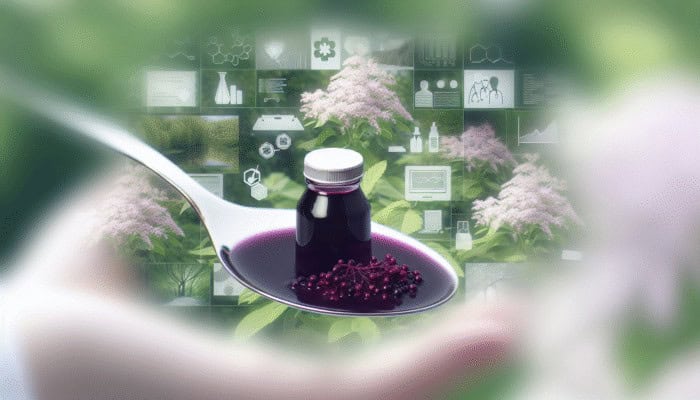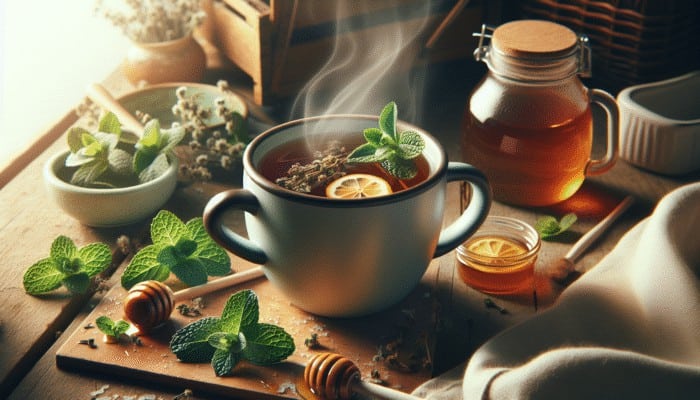Crafting Your Own Elderberry Syrup for Natural Wellness
Step-by-Step Guide to Preparing Elderberry Syrup

Simple Herbal Remedies for Colds: Creating your elderberry syrup is not only an enjoyable endeavour but also a fulfilling way to harness the healing properties of nature right from your kitchen. To start, seek out fresh elderberries, which are abundant in the wild across the UK from late summer to early autumn. After gathering a sufficient amount, rinse the berries thoroughly to eliminate any dirt or insects that may be present. In a pot, mix approximately one cup of elderberries with four cups of water. Then, add half a cup of sugar, along with a pinch of spices such as cinnamon or cloves, to enhance the flavour. Bring the mixture to a boil, then reduce the heat and simmer for approximately 30 minutes. During this time, the berries will break down, releasing their valuable nutrients into the syrup. After cooling, strain the liquid through a fine sieve or cheesecloth to remove any solids. Store your homemade syrup in a sterilised glass jar or bottle in a cool place or the refrigerator, and remember to consume it within a few weeks. Taking a spoonful daily can help ward off cold symptoms effectively.
Exploring the Health Benefits of Elderberry Syrup
The advantages of natural herbal remedies for colds are beautifully encapsulated in elderberry syrup. This potent elixir boasts a high concentration of antioxidants, particularly flavonoids, which play a vital role in combating oxidative stress within the body. Research indicates that elderberry can significantly reduce the duration of cold symptoms, making it a favourite choice among herbal enthusiasts and health-conscious individuals alike. Its abundant vitamin C content bolsters the immune system, enhancing your body's innate defences against illness. Additionally, elderberry contains anti-inflammatory compounds that may help reduce swelling in the respiratory passages, thereby facilitating easier breathing during a cold. This gentle yet effective remedy is suitable for both adults and children; however, it is always wise to consult with a healthcare professional regarding specific health concerns or conditions before use.
Finding Elderberries: A Foraging Adventure in the UK
Locating elderberries in the UK can be an exciting adventure, particularly for those who enjoy foraging. Keep an eye out for elder trees in hedgerows and woodlands, particularly in picturesque areas such as the Yorkshire countryside or the expansive forests of Scotland. If you do not wish to forage, elderberries are readily available at local markets, especially during their harvest season. Health food stores also stock a variety of elderberry products, including syrups and capsules, ensuring year-round accessibility. This availability means you can effortlessly integrate this natural remedy for colds into your wellness routine, offering a convenient option for maintaining your health.
Determining the Right Dosage of Elderberry Syrup

For adults, the typical dosage for elderberry syrup is generally one tablespoon daily, while children can benefit from a reduced dosage of one teaspoon. However, it is crucial to consult with a healthcare provider to tailor the dosage to your individual needs, particularly for those with pre-existing health conditions or women who are pregnant. Given that elderberry is a potent remedy, personalisation of the dosage ensures that you receive the maximum benefits without encountering any adverse effects.
Understanding Potential Side Effects of Elderberry Syrup
While elderberry syrup is considered generally safe, some individuals may experience mild side effects, including digestive upset or allergic reactions. It is essential to monitor your body's response, particularly if you are new to using herbal remedies. Additionally, elderberry can interact with certain medications, especially those that affect the immune system. Therefore, consulting with a healthcare professional before beginning use is advisable, as this will help you avoid potential complications and ensure safe consumption.
Preparing a Delightful Cup of Peppermint Tea
Easy Steps to Brew Refreshing Peppermint Tea

Brewing a comforting cup of peppermint tea is not only simple but also a delightful way to experience the numerous benefits of this aromatic herb. The process begins with either fresh or dried peppermint leaves, which are widely accessible in UK supermarkets, or, if you have a garden, you may even grow your own. To prepare the tea, take a handful of fresh leaves or 1 to 2 teaspoons of dried peppermint and steep them in hot water — ideally just off the boil — for 5 to 10 minutes. The longer you steep the leaves, the stronger the flavour will be. For an extra touch of sweetness or acidity, consider adding a drizzle of honey or a slice of lemon. This fragrant infusion serves as a comforting remedy that can be enjoyed throughout the day, especially during the cold and flu season when its soothing properties are most needed.
Uncovering the Soothing Properties of Peppermint Tea
Peppermint tea is more than just a delightful beverage; it serves as a powerful ally against various cold symptoms. The menthol present in peppermint acts as a natural decongestant, helping to clear nasal passages and relieve sinus pressure effectively. This makes it particularly beneficial for individuals suffering from congestion or a blocked nose. Furthermore, peppermint possesses soothing properties that can alleviate sore throats, providing a gentle cooling sensation that eases discomfort. Regular consumption of peppermint tea can also promote relaxation, making it an ideal choice to enjoy before bedtime, especially when you are feeling unwell.
Where to Source Fresh Peppermint in the UK
One of the most appealing aspects of peppermint is its accessibility. In the UK, peppermint plants can be found in numerous gardens, and they are remarkably easy to grow, thriving in pots or garden beds. If you prefer purchasing peppermint rather than growing it yourself, local nurseries often stock young peppermint plants. Supermarkets typically offer both fresh mint leaves and dried tea bags, making it a convenient option for anyone looking to incorporate herbal remedies into their daily routine. By sourcing local peppermint, you not only enjoy the vibrant flavours but also support local growers, contributing positively to your community.
Creating Your Own Echinacea Tincture
Step-by-Step Instructions for Making Echinacea Tincture
Crafting your echinacea tincture is a gratifying process that allows you to harness the remarkable health benefits of this renowned herb. Begin by obtaining dried echinacea roots, which can be conveniently purchased at health food stores or online retailers. To create the tincture, soak the roots in high-proof alcohol, such as vodka, for several weeks, shaking the mixture daily to promote proper infusion. After a period of two to six weeks, strain the liquid through a fine sieve or cheesecloth to remove any plant material. The resulting tincture can be diluted in water or taken directly, with a few drops typically recommended for daily use. This concentrated form of echinacea serves as a powerful method to support and boost your immune system.
Immune Support: The Benefits of Echinacea
Echinacea is celebrated for its ability to stimulate the immune system, making it one of the most popular natural remedies for colds. Research indicates that echinacea can effectively reduce the severity and duration of colds by enhancing the activity of white blood cells, which play a crucial role in combating infections. Regular use of echinacea tincture may help your body resist colds, particularly during peak seasons when viral infections are more prevalent. This remedy is especially beneficial for individuals with weakened immune systems or those frequently exposed to illnesses, providing an additional layer of support during challenging times.
Finding Quality Echinacea Products in the UK
Locating high-quality echinacea products in the UK is a straightforward task. Health food shops throughout the country often stock a diverse range of echinacea forms, including tinctures, capsules, and dried roots. Well-known chains like Holland & Barrett typically carry a selection of echinacea products, making them easily accessible for those seeking natural remedies. Additionally, many local herbalists offer fresh echinacea plants, which are ideal for those who prefer to cultivate their remedies at home, allowing for a deeper connection to the healing properties of this remarkable herb.
Recommended Dosage for Echinacea Tincture
When it comes to the dosage of echinacea tincture, starting with 1-2 ml taken three times daily is often recommended. However, individual responses to echinacea can vary significantly, making it vital to adjust the dosage based on your personal experience and needs. Always consult a healthcare provider for tailored advice, particularly if you are pregnant, nursing, or taking medication, ensuring that you maximise the benefits without encountering unwanted side effects.
Understanding Potential Side Effects of Echinacea
While echinacea is generally well-tolerated by most individuals, some may experience side effects such as allergic reactions, gastrointestinal upset, or dizziness. If you notice any adverse symptoms, it is essential to discontinue use and seek medical advice promptly. Furthermore, echinacea may interact with certain medications, particularly those that suppress the immune system; therefore, it is essential to consult a healthcare provider before use to ensure a safe and effective experience.
Infusing Thyme for Health Benefits
Creating a Thyme Infusion: A Simple Technique
Creating a thyme infusion is a straightforward yet effective method to utilise this robust herb, particularly during the cold season. Begin by boiling water in a kettle, then add a few sprigs of fresh thyme or 1 to 2 teaspoons of dried thyme leaves to a heatproof container. Pour the boiling water over the thyme and allow it to steep for approximately 10 minutes. The longer you let it steep, the more potent the infusion will become. After steeping, strain the mixture to remove the thyme leaves and enjoy it warm. For added flavour and health benefits, consider incorporating a drizzle of honey or a squeeze of lemon, which can enhance its therapeutic effects and overall enjoyment.
Thyme's Respiratory Relief: Natural Healing Properties
Thyme is highly regarded for its antiseptic properties, making it an excellent choice for alleviating respiratory issues associated with colds and flu. The active compounds found in thyme, such as thymol, have demonstrated antibacterial and antiviral effects, aiding in the relief of coughs and soothing sore throats. When you sip on thyme infusion, the steam can also help clear your nasal passages, allowing for easier breathing. This makes thyme a powerful ally for individuals dealing with congestion or bronchial irritation linked to colds, providing a natural and effective remedy.
Local Sources for Thyme in the UK
In the UK, thyme is readily available and can typically be found in most supermarkets, making it easy for anyone to incorporate this beneficial herb into their health regimen. Additionally, thyme is a popular herb to grow in personal gardens; it thrives in pots and requires minimal maintenance, making it an ideal choice for novice gardeners. By cultivating your thyme, you ensure a steady supply of this potent herb, allowing you to create infusions at home whenever needed, and thereby enhancing your connection to the natural world.
The Power of Garlic and Honey for Cold Relief
How to Prepare the Garlic and Honey Mixture
Combining garlic and honey creates a potent mixture that harnesses the numerous health benefits of both ingredients. To begin, crush several garlic cloves; this process activates allicin, the compound responsible for garlic’s impressive medicinal properties. Once crushed, mix the garlic with raw honey in a jar, allowing it to sit for a few days to enable the flavours and health benefits to meld together. This sweet elixir can be taken by the spoonful daily, providing natural relief from cold symptoms. The preparation is simple and can be easily made at home, ensuring you have a powerful natural remedy ready whenever you need it.
Exploring the Antimicrobial Effects of Garlic and Honey
The combination of garlic and honey forms a powerhouse in the realm of natural remedies for colds. Garlic possesses notable antimicrobial properties that can help in combating infections, while honey acts as a soothing agent, particularly effective for sore throats. Together, they create a synergistic effect that not only alleviates symptoms but also helps combat the underlying causes of colds. Research has shown that garlic can enhance immune function, making this combination particularly effective during the cold season. Additionally, the natural sweetness of honey enhances its palatability, making it a delicious and beneficial addition to your daily wellness routine.
Accessibility of Garlic and Honey in the UK
Both garlic and honey are staple ingredients found in many UK kitchens, making this remedy incredibly accessible. Garlic is readily available in supermarkets and local markets throughout the year, while honey, especially raw or local varieties, can be found at health food shops or farmers' markets. This means that anyone can easily whip up this herbal concoction without the need for specialised ingredients, making it a fantastic option for those seeking natural alternatives to over-the-counter cold medications. The simplicity and effectiveness of this remedy make it a go-to choice for many households nationwide.
Brewing Refreshing Lemon and Ginger Tea
Step-by-Step Brewing Process for Lemon and Ginger Tea
Brewing a cup of lemon and ginger tea is a delightful ritual that not only offers comfort but also a variety of health benefits. Start by slicing fresh ginger root and a lemon, then place them in a saucepan filled with water. Bring the mixture to a boil, allowing the flavours to meld for approximately 10 minutes. After boiling, remove from the heat and let it steep for a few additional minutes to enhance the infusion. You can sweeten your tea with honey to further enrich its taste and health benefits. This zesty infusion is not only refreshing but also serves as a powerful remedy for cold symptoms, making it a favourite choice during the colder months when colds are prevalent.
Exploring the Cold-Fighting Properties of Lemon and Ginger
Lemon and ginger are renowned for their potent cold-fighting properties. Ginger is rich in anti-inflammatory compounds that can help alleviate congestion and soothe a sore throat. At the same time, lemon is rich in vitamin C, which is essential for strengthening the immune system. Regularly consuming this tea during the cold season can significantly support your body in fighting off illnesses more effectively. Furthermore, the warmth of the tea can help ease body aches and provide comfort during recovery, making it an invaluable addition to your herbal arsenal for combating cold symptoms.
Availability of Ginger and Lemons in the UK
Ginger and lemons are commonly found in UK supermarkets, ensuring that you can easily access these key ingredients whenever you need them. Fresh ginger is typically located in the produce section, while lemons are available year-round. Local markets may also offer seasonal varieties, providing you with a range of options to choose from. This accessibility makes it straightforward to incorporate lemon and ginger tea into your daily routine, particularly during the cold and flu season when it is most beneficial.
Additional Health Benefits of Lemon and Ginger Tea
Beyond their immediate cold-fighting benefits, lemon and ginger tea provide a range of additional health advantages. This combination aids digestion, boosts immunity, and can even help alleviate nausea. Drinking this infusion regularly not only enhances your overall well-being but can also serve as a comforting drink to enjoy during chilly evenings. Its warming properties provide a sense of comfort, making it a go-to remedy for many households in the UK, especially as the weather turns cold and flu season approaches.
Utilising Sage Gargle for Sore Throat Relief
Effective Gargling Method with Sage
A sage gargle is a simple yet effective method to soothe a sore throat, harnessing the antibacterial properties inherent in sage. To prepare, boil fresh sage leaves in water, allowing them to infuse for about 10 minutes. Once the mixture has cooled to a comfortable temperature, use it as a gargle to rinse your throat. This herbal remedy is not only easy to make but also provides immediate relief from discomfort caused by colds or respiratory infections. Regularly using a sage gargle may help alleviate throat irritation, making it a valuable addition to your herbal toolkit for combating cold symptoms.
Frequently Asked Questions About Herbal Remedies for Colds
What Are the Most Effective Natural Remedies for Colds?
The most effective natural remedies for colds include elderberry syrup, peppermint tea, echinacea tincture, thyme infusion, garlic and honey, lemon and ginger tea, and a sage gargle. Each of these remedies offers unique benefits to naturally alleviate cold symptoms, providing a holistic approach to wellness.
How Does Elderberry Syrup Aid in Cold Recovery?
Elderberry syrup is rich in antioxidants and vitamin C, which can significantly boost the immune system and shorten the duration of cold symptoms, making it a popular choice during the cold season for those seeking natural relief.
Can I Grow My Own Peppermint at Home?
Yes, peppermint is incredibly easy to grow in pots or gardens and thrives in most UK climates. It’s a wonderful addition to your herb garden, providing fresh leaves for tea and various culinary uses.
What Is the Best Way to Take Echinacea for Maximum Benefits?
Echinacea can be taken in tincture, tea, or capsule form. The tincture is typically taken in doses of 1-2 ml three times daily to provide optimal immune support and benefits during the cold season.
Are There Any Side Effects Associated with Garlic and Honey?
While generally safe, garlic can cause digestive upset in some individuals. Additionally, honey should not be given to infants under one year old due to the risk of botulism, which can be dangerous for young children.
How Often Can I Drink Lemon and Ginger Tea for Best Results?
You can enjoy lemon and ginger tea daily, particularly during the cold season when its anti-inflammatory properties make it a beneficial addition to your wellness routine and help combat cold symptoms effectively.
What Symptoms Can Thyme Infusion Help Alleviate?
Thyme infusion can effectively alleviate coughs, sore throats, and congestion due to its antiseptic and soothing properties, making it a fantastic herbal remedy for colds and respiratory discomfort.
How Long Does It Take to Make Echinacea Tincture?
Preparing echinacea tincture typically takes about 2 to 6 weeks to infuse properly, so it is advisable to plan if you want to have this remedy ready for when colds strike and your body needs support.
Is It Safe to Gargle with Sage for Throat Relief?
Yes, gargling with sage is safe and effective for soothing sore throats due to its antibacterial properties; however, ensure the mixture has cooled sufficiently to avoid burns and provide a comfortable experience.
Where Can I Find These Herbs and Remedies in the UK?
Many herbs such as elderberry, peppermint, echinacea, thyme, garlic, and ginger are widely available in UK supermarkets, local markets, and health food shops. Additionally, these herbs can be easily grown at home, providing a sustainable option for anyone interested in natural remedies.
























1 Comment
I really appreciate this step-by-step guide on making elderberry syrup! It reminds me of the many ways we can incorporate natural remedies into our daily wellness routines. The fact that elderberries are so accessible, especially in late summer and early autumn, makes the process even more appealing. I remember my first attempt at making elderberry syrup a few years ago. It was a bit chaotic—I think I ended up with more splatters on my kitchen wall than syrup in the pot! But it was so satisfying to see that vibrant, deep purple liquid come together, and the smell of the spices simmering was divine.